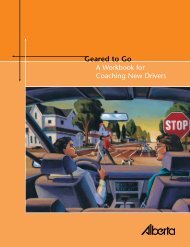Commercial driver's guide to operation, safety and licensing
Commercial driver's guide to operation, safety and licensing
Commercial driver's guide to operation, safety and licensing
You also want an ePaper? Increase the reach of your titles
YUMPU automatically turns print PDFs into web optimized ePapers that Google loves.
Reversing from the blind side uses<br />
the same steps as clear side reversing.<br />
However, it is harder <strong>to</strong> see where you are<br />
going. Once the reversing has started, you<br />
will mostly be using the right side mirror,<br />
including the convex mirror.<br />
You should s<strong>to</strong>p often <strong>and</strong> get out of the<br />
trac<strong>to</strong>r <strong>to</strong> check your position.<br />
This type of reversing is the most<br />
difficult <strong>and</strong> also potentially the most<br />
dangerous. Avoid it if you can.<br />
Important information<br />
for commercial<br />
drivers<br />
• When carrying logs on a vehicle, the<br />
overhanging logs may swing across the<br />
other traffic lanes when you turn. Try <strong>to</strong><br />
let traffic behind pass before you make<br />
the turn.<br />
• If a breakdown occurs on the highway,<br />
park the vehicle as soon as possible,<br />
in a safe position on the right side<br />
of the roadway.<br />
• If the breakdown occurs on a<br />
highway, outside the limits of an urban<br />
municipality between sunrise <strong>and</strong> sunset<br />
(during the day), activate the emergency<br />
hazard lights. Place an approved<br />
warning device on the highway in line<br />
with the vehicle about 30 metres (about<br />
100 feet) in both front <strong>and</strong> reverse<br />
of the vehicle.<br />
• If the breakdown occurs on a<br />
highway, outside the limits of an urban<br />
municipality between sunset <strong>and</strong><br />
sunrise (in darkness), or anytime when<br />
there is not enough light <strong>to</strong> clearly see<br />
people or vehicles on a highway at a<br />
distance of 150 metres, activate the<br />
emergency hazard lights. Place an<br />
approved warning device 75 metres<br />
(about 250 feet) in front of <strong>and</strong> behind<br />
the vehicle.<br />
• If your truck is carrying explosives or<br />
flammable goods, you must s<strong>to</strong>p before<br />
every uncontrolled railway crossing.<br />
• When driving in urban areas (cities<br />
<strong>and</strong> <strong>to</strong>wns), you must drive only on<br />
the routes specified for trucks <strong>and</strong><br />
dangerous goods vehicles.<br />
• If driving a vehicle that carries<br />
dangerous goods, you must comply<br />
with the federal <strong>and</strong> provincial laws<br />
describing how dangerous goods<br />
should be h<strong>and</strong>led, s<strong>to</strong>red <strong>and</strong><br />
transported.<br />
If a vehicle’s load reaches or extends<br />
more than 1.5 metres beyond the rear of<br />
the vehicle, the following is required:<br />
• During daylight hours, a red flag, not<br />
less than 30 centimetres square, must<br />
be attached <strong>to</strong> the end of the extension.<br />
• During nighttime hours, a red light must<br />
be attached <strong>to</strong> the end of the extension.<br />
Note: If your truck or vehicle is carrying<br />
goods or commodities <strong>to</strong> the United<br />
States, <strong>and</strong> this is not something you<br />
do on a regular scheduled basis, you<br />
must contact either the Department of<br />
Transportation or the Department of<br />
Highways in each state where you will<br />
be travelling before starting your trip.<br />
Each state has different laws. Your trip<br />
will be faster <strong>and</strong> smoother if you obtain<br />
all the proper permits <strong>and</strong> documents<br />
before you go.<br />
52 A <strong>Commercial</strong> Driver’s Guide <strong>to</strong> Operation, Safety <strong>and</strong> Licensing




